Tomcat启动流程
源码构建
1. 源码下载
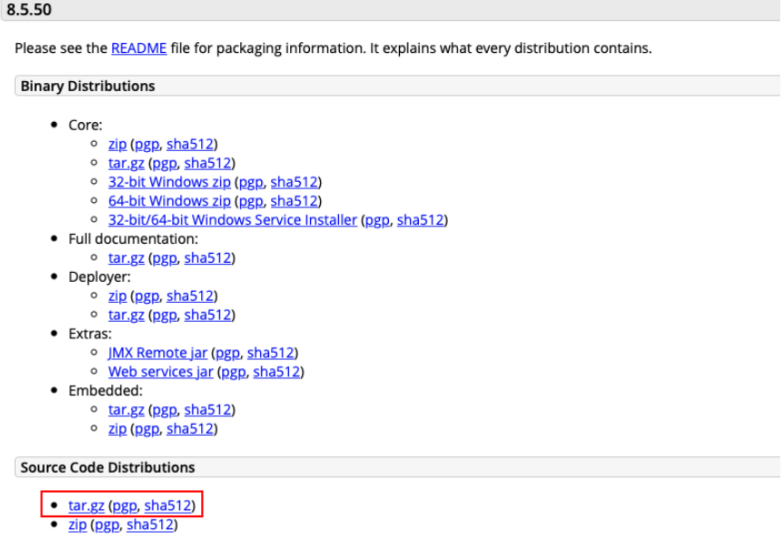
2. 准备工作
-
- 解压 tar.gz 压缩包,得到⽬录 apache-tomcat-8.5.50-src
-
- 进⼊ apache-tomcat-8.5.50-src ⽬录,创建⼀个pom.xml⽂件,⽂件内容如下
<?xml version="1.0" encoding="UTF-8"?>
<project xmlns="http://maven.apache.org/POM/4.0.0"
xmlns:xsi="http://www.w3.org/2001/XMLSchema-instance"
xsi:schemaLocation="http://maven.apache.org/POM/4.0.0
http://maven.apache.org/xsd/maven-4.0.0.xsd">
<modelVersion>4.0.0</modelVersion>
<groupId>org.apache.tomcat</groupId>
<artifactId>apache-tomcat-8.5.50-src</artifactId>
<name>Tomcat8.5</name>
<version>8.5</version>
<!--tomcat 依赖的基础包-->
<dependencies>
<dependency>
<groupId>org.easymock</groupId>
<artifactId>easymock</artifactId>
<version>3.4</version>
</dependency>
<dependency>
<groupId>ant</groupId>
<artifactId>ant</artifactId>
<version>1.7.0</version>
</dependency>
<dependency>
<groupId>wsdl4j</groupId>
<artifactId>wsdl4j</artifactId>
<version>1.6.2</version>
</dependency>
<dependency>
<groupId>javax.xml</groupId>
<artifactId>jaxrpc</artifactId>
<version>1.1</version>
</dependency>
<dependency>
<groupId>org.eclipse.jdt.core.compiler</groupId>
<artifactId>ecj</artifactId>
<version>4.5.1</version>
</dependency>
<dependency>
<groupId>javax.xml.soap</groupId>
<artifactId>javax.xml.soap-api</artifactId>
<version>1.4.0</version>
</dependency>
</dependencies>
<build>
<!--指定源⽬录-->
<finalName>Tomcat8.5</finalName>
<sourceDirectory>java</sourceDirectory>
<resources>
<resource>
<directory>java</directory>
</resource>
</resources>
<plugins>
<!--引⼊编译插件-->
<plugin>
<groupId>org.apache.maven.plugins</groupId>
<artifactId>maven-compiler-plugin</artifactId>
<version>3.1</version>
<configuration>
<encoding>UTF-8</encoding>
<source>8</source>
<target>8</target>
</configuration>
</plugin>
</plugins>
</build>
</project>
-
- 在 apache-tomcat-8.5.50-src ⽬录中创建 source ⽂件夹
-
- 将 conf、webapps ⽬录移动到刚刚创建的 source ⽂件夹中
3. 将项目导入到idea中
- 3.1 程序启动类 Bootstrap 配置 VM 参数
-Dcatalina.home=D:\IdeaProjects\serverrepository\work\Tomcat\apache-tomcat-8.5.50-src\source
-Dcatalina.base=D:\IdeaProjects\serverrepository\work\Tomcat\apache-tomcat-8.5.50-src\source
-Djava.util.logging.manager=org.apache.juli.ClassLoaderLogManager
-Djava.util.logging.config.file=D:\IdeaProjects\serverrepository\work\Tomcat\apache-tomcat-8.5.50-src\source\conf\logging.properties
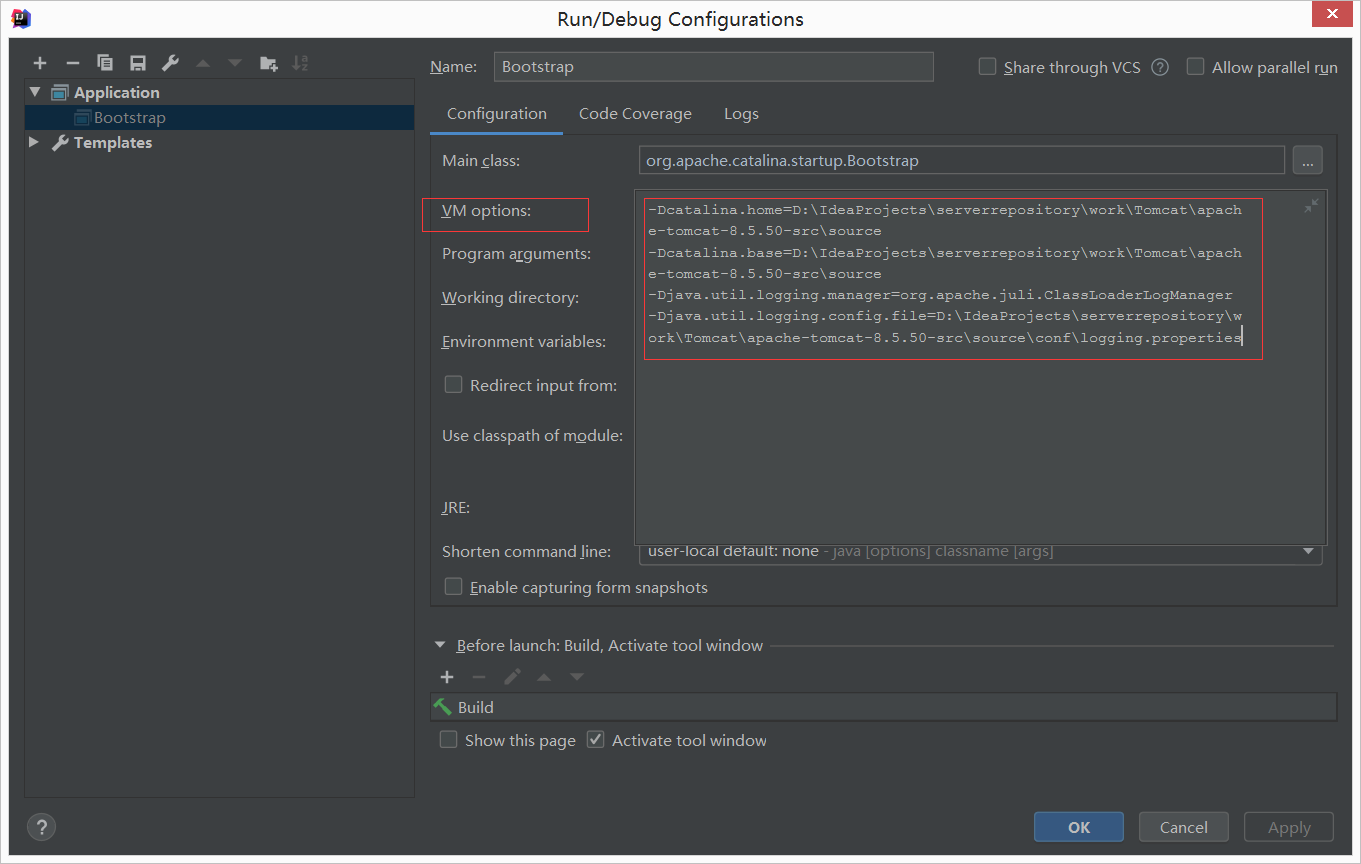
-
3.2 ContextConfig 类中的 configureStart 方法添加代码:
context.addServletContainerInitializer(new JasperInitializer(), null);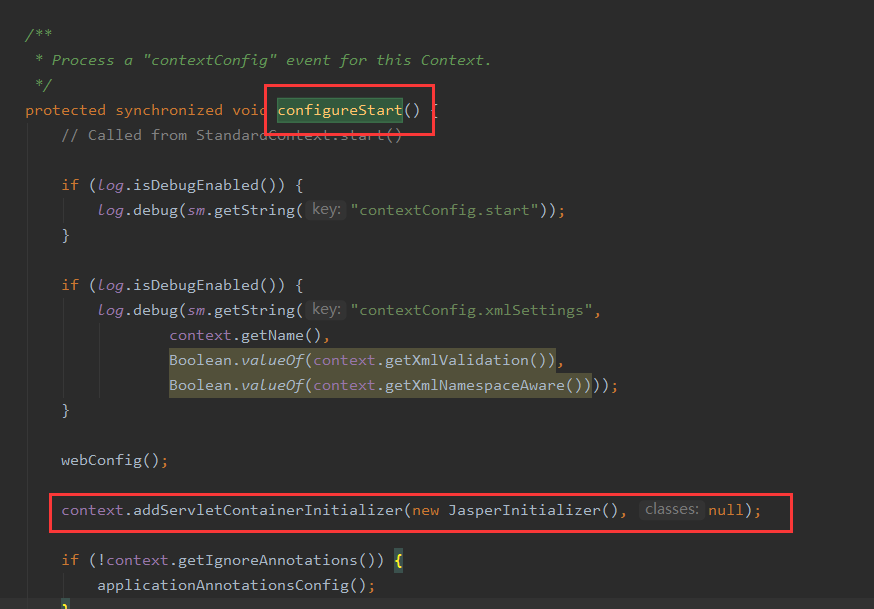
-
3.3 启动程序 Bootstrap
-
3.4 浏览器访问 http://localhost:8080
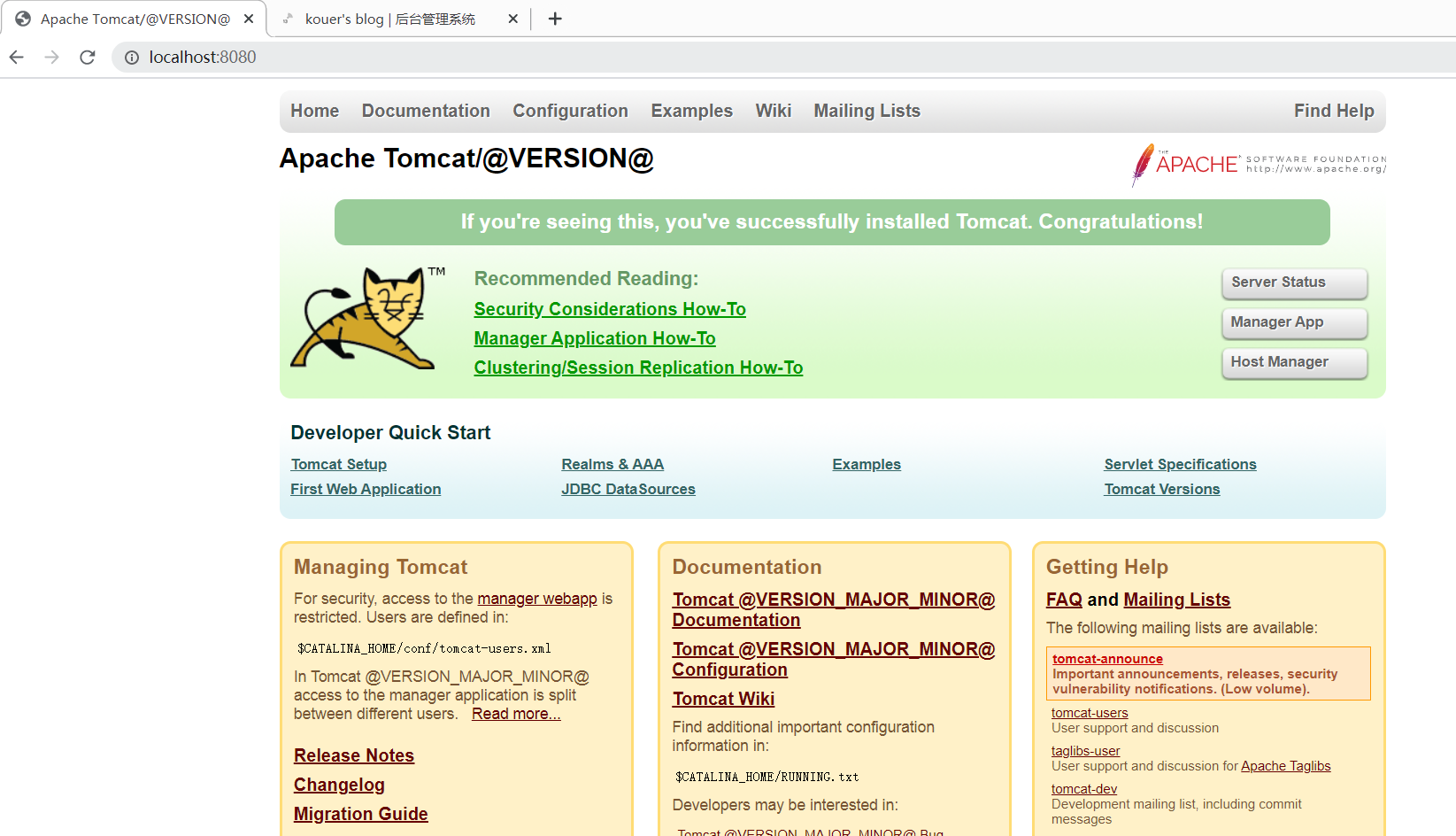
2. 核⼼流程源码剖析
Tomcat中的各容器组件都会涉及创建、销毁等,因此设计了⽣命周期接⼝Lifecycle进⾏统⼀规范,各容器组件实现该接⼝。
Lifecycle 接口示意图:
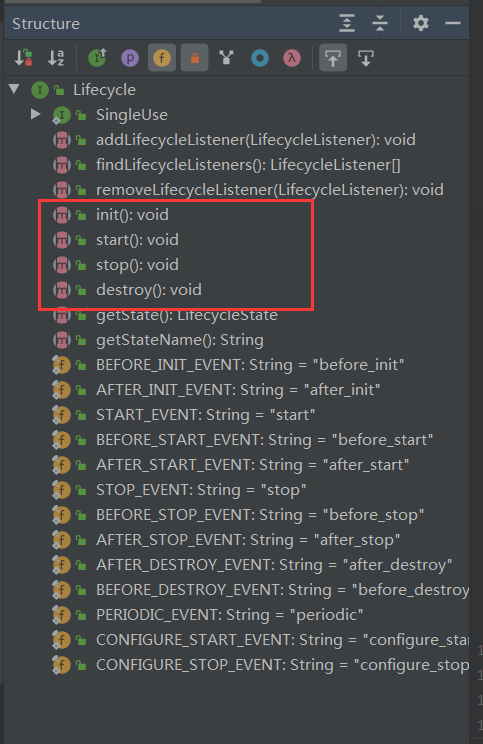
Lifecycle 接口继承体系示意图:
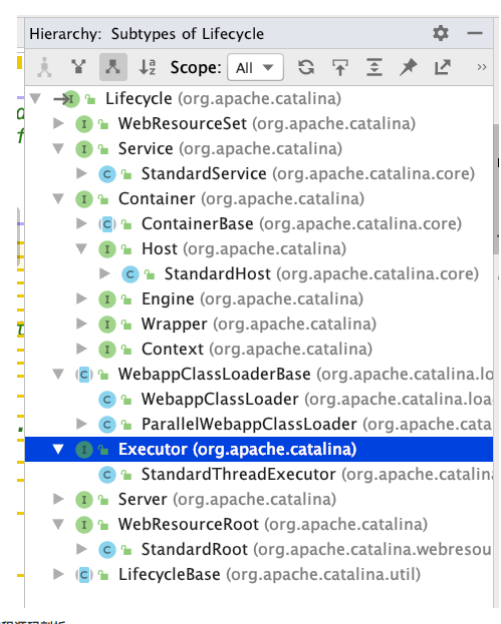
2.1 Tomcat启动流程
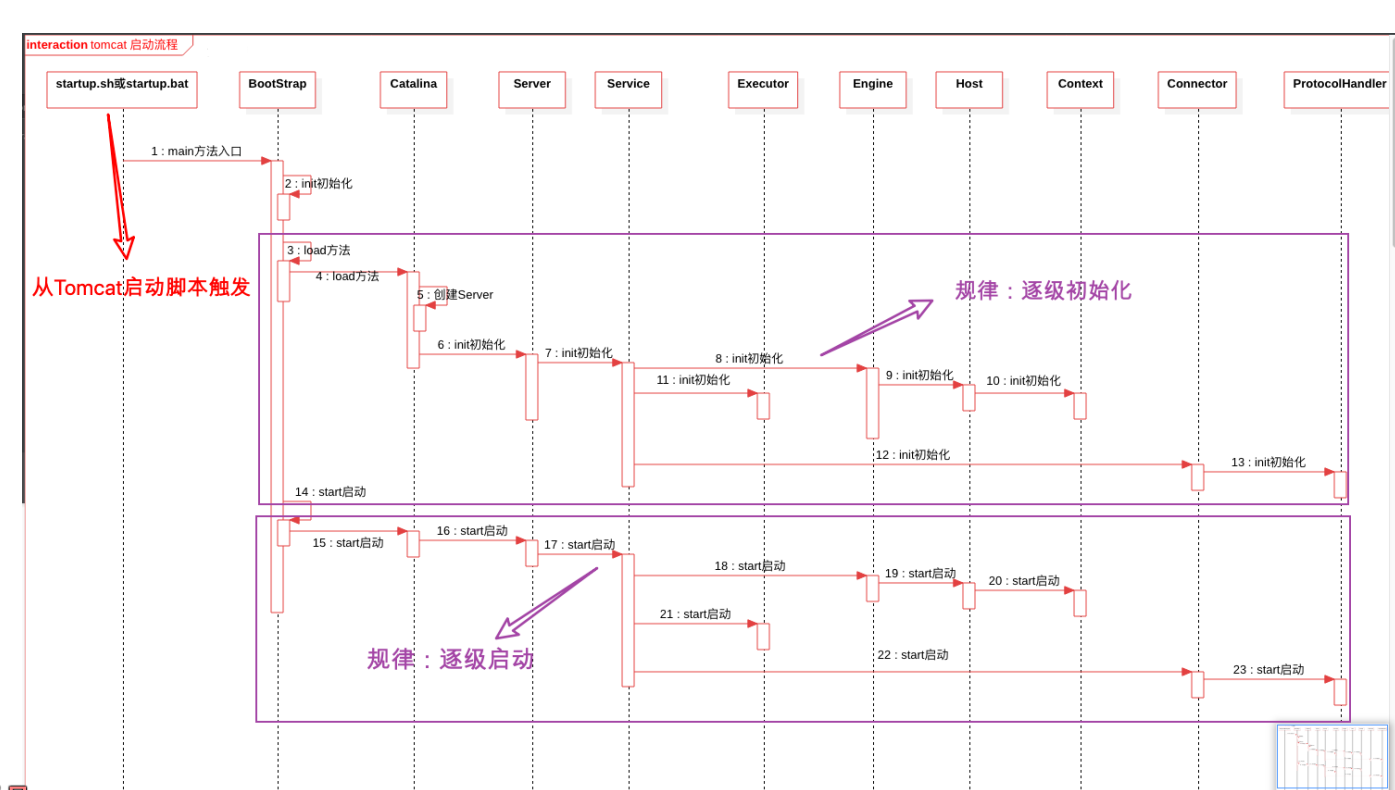
主要跟踪三个地方:
- bootstrap.init();
- daemon.load(args);
- daemon.start();
2.1.1 初始化参数、容器
main函数
/**
* Main method and entry point when starting Tomcat via the provided
* scripts.
*
* @param args Command line arguments to be processed
*/
public static void main(String args[]) {
synchronized (daemonLock) {
if (daemon == null) {
// Don't set daemon until init() has completed
Bootstrap bootstrap = new Bootstrap();
try {
// 初始化 Catalina
bootstrap.init();
} catch (Throwable t) {
handleThrowable(t);
t.printStackTrace();
return;
}
daemon = bootstrap;
} else {
// When running as a service the call to stop will be on a new
// thread so make sure the correct class loader is used to
// prevent a range of class not found exceptions.
Thread.currentThread().setContextClassLoader(daemon.catalinaLoader);
}
}
try {
String command = "start";
if (args.length > 0) {
command = args[args.length - 1];
}
if (command.equals("startd")) {
args[args.length - 1] = "start";
// 加载进程 初始化各个容器
daemon.load(args);
// 启动容器
daemon.start();
} else if (command.equals("stopd")) {
args[args.length - 1] = "stop";
daemon.stop();
} else if (command.equals("start")) {
daemon.setAwait(true);
daemon.load(args);
daemon.start();
if (null == daemon.getServer()) {
System.exit(1);
}
} else if (command.equals("stop")) {
daemon.stopServer(args);
} else if (command.equals("configtest")) {
daemon.load(args);
if (null == daemon.getServer()) {
System.exit(1);
}
System.exit(0);
} else {
log.warn("Bootstrap: command \"" + command + "\" does not exist.");
}
} catch (Throwable t) {
// Unwrap the Exception for clearer error reporting
if (t instanceof InvocationTargetException &&
t.getCause() != null) {
t = t.getCause();
}
handleThrowable(t);
t.printStackTrace();
System.exit(1);
}
}
bootstrap.init(); org.apache.catalina.startup.Bootstrap#init()
/**
* Initialize daemon.
* @throws Exception Fatal initialization error
*/
public void init() throws Exception {
// 初始化classLoader
initClassLoaders();
// 为当前线程设置classLoader
Thread.currentThread().setContextClassLoader(catalinaLoader);
SecurityClassLoad.securityClassLoad(catalinaLoader);
// Load our startup class and call its process() method
// 加载启动类并调用process()
if (log.isDebugEnabled())
log.debug("Loading startup class");
// org.apache.catalina.startup.Catalina 启动类
Class<?> startupClass = catalinaLoader.loadClass("org.apache.catalina.startup.Catalina");
Object startupInstance = startupClass.getConstructor().newInstance();
// Set the shared extensions class loader
if (log.isDebugEnabled())
log.debug("Setting startup class properties");
String methodName = "setParentClassLoader";
Class<?> paramTypes[] = new Class[1];
paramTypes[0] = Class.forName("java.lang.ClassLoader");
Object paramValues[] = new Object[1];
paramValues[0] = sharedLoader;
Method method =
startupInstance.getClass().getMethod(methodName, paramTypes);
method.invoke(startupInstance, paramValues);
// 为 catalinaDaemon 赋值为 org.apache.catalina.startup.Catalina
catalinaDaemon = startupInstance;
}
daemon.load(args); org.apache.catalina.startup.Bootstrap#load
/**
* Load daemon.
*/
private void load(String[] arguments) throws Exception {
// Call the load() method
String methodName = "load";
Object param[];
Class<?> paramTypes[];
if (arguments==null || arguments.length==0) {
paramTypes = null;
param = null;
} else {
paramTypes = new Class[1];
paramTypes[0] = arguments.getClass();
param = new Object[1];
param[0] = arguments;
}
Method method =
catalinaDaemon.getClass().getMethod(methodName, paramTypes);
if (log.isDebugEnabled()) {
log.debug("Calling startup class " + method);
}
// 反射调用 Catalina 的 load 方法
method.invoke(catalinaDaemon, param);
}
daemon.start(); org.apache.catalina.startup.Bootstrap#start
/**
* Start the Catalina daemon.
* @throws Exception Fatal start error
*/
public void start() throws Exception {
// 如果Catalina还没初始化,再调用init()去初始化Catalina
if (catalinaDaemon == null) {
init();
}
Method method = catalinaDaemon.getClass().getMethod("start", (Class [])null);
// 反射调用Catalina的start()方法
method.invoke(catalinaDaemon, (Object [])null);
}
Catalina 中的load()
/**
* Start a new server instance.
*/
public void load() {
if (loaded) {
return;
}
loaded = true;
long t1 = System.nanoTime();
// 初始化java.io.tmpdir中的目录
initDirs();
// Before digester - it may be needed
// 初始化命名空间
initNaming();
// Create and execute our Digester
// 创建容器
Digester digester = createStartDigester();
InputSource inputSource = null;
InputStream inputStream = null;
File file = null;
try {
try {
// 加载 conf/server.xml
file = configFile();
inputStream = new FileInputStream(file);
inputSource = new InputSource(file.toURI().toURL().toString());
} catch (Exception e) {
if (log.isDebugEnabled()) {
log.debug(sm.getString("catalina.configFail", file), e);
}
}
// 省略部分代码
} finally {
if (inputStream != null) {
try {
inputStream.close();
} catch (IOException e) {
// Ignore
}
}
}
getServer().setCatalina(this);
getServer().setCatalinaHome(Bootstrap.getCatalinaHomeFile());
getServer().setCatalinaBase(Bootstrap.getCatalinaBaseFile());
// Stream redirection
initStreams();
// Start the new server
try {
// getServer() : 获取Catalina下的server
// init() 调用server的init()方法
getServer().init();
} catch (LifecycleException e) {
if (Boolean.getBoolean("org.apache.catalina.startup.EXIT_ON_INIT_FAILURE")) {
throw new java.lang.Error(e);
} else {
log.error("Catalina.start", e);
}
}
long t2 = System.nanoTime();
if(log.isInfoEnabled()) {
log.info("Initialization processed in " + ((t2 - t1) / 1000000) + " ms");
}
}
load()中主要步骤就是 getServer().init(); 调用server中的方法, 因为tomcat中所有实体都实现了Lifecycle接口,所以调用的init是接口的方法,
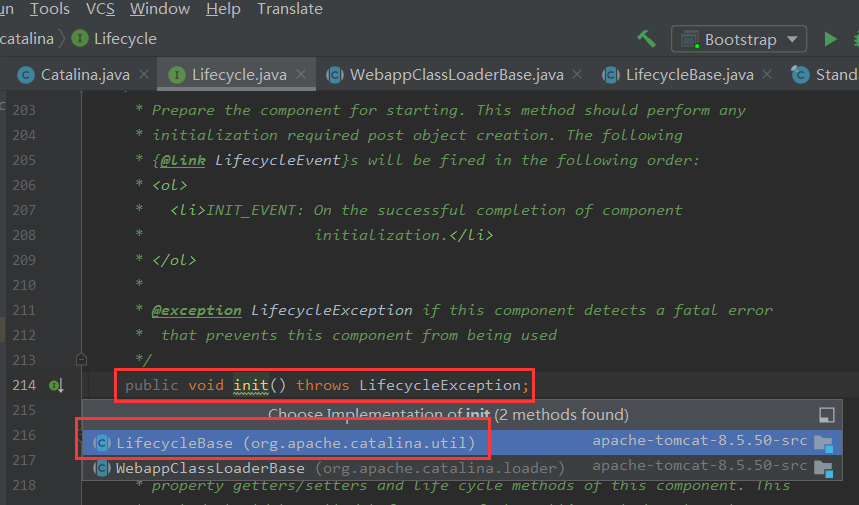
默认调用 org.apache.catalina.util.LifecycleBase的init方法
@Override
public final synchronized void init() throws LifecycleException {
if (!state.equals(LifecycleState.NEW)) {
invalidTransition(Lifecycle.BEFORE_INIT_EVENT);
}
try {
setStateInternal(LifecycleState.INITIALIZING, null, false);
// 初始化内部的容器
initInternal();
setStateInternal(LifecycleState.INITIALIZED, null, false);
} catch (Throwable t) {
handleSubClassException(t, "lifecycleBase.initFail", toString());
}
}
而initInternal() 是一个abstract方法
/**
* Sub-classes implement this method to perform any instance initialisation
* required.
*
* @throws LifecycleException If the initialisation fails
*/
protected abstract void initInternal() throws LifecycleException;
实现类
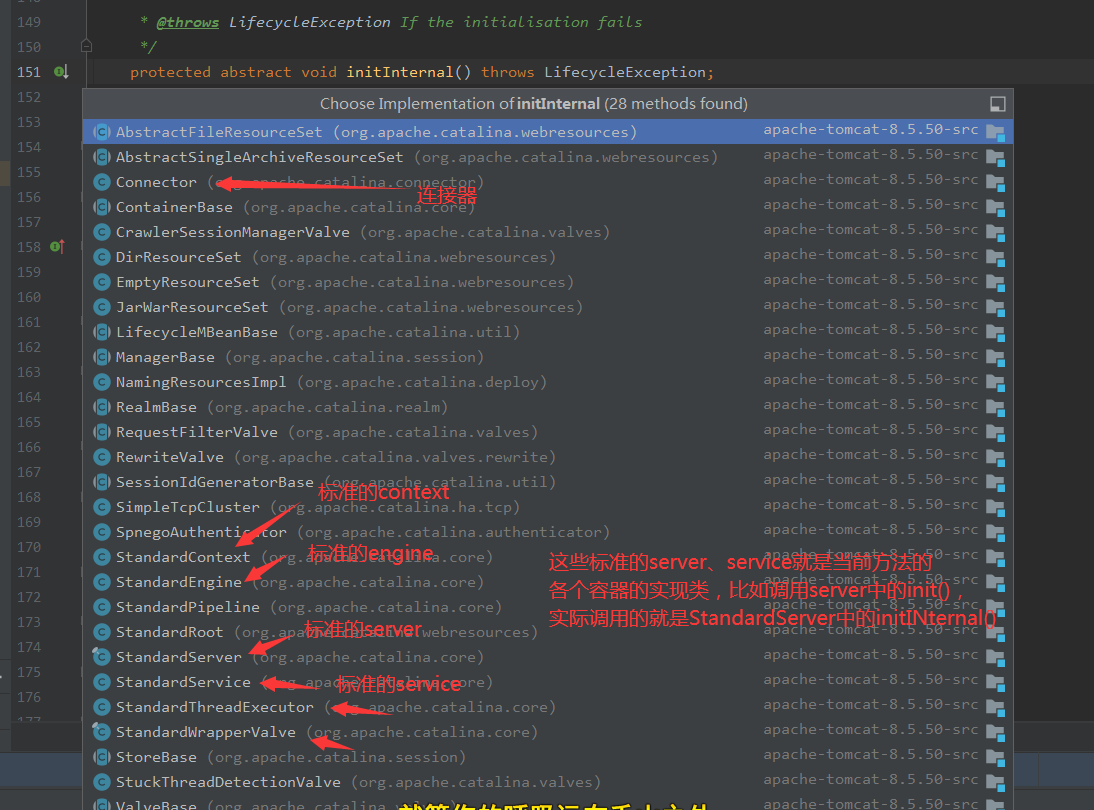
因为我们当前的步骤在调用server中的init(),所以就要选择进入 org.apache.catalina.core.StandardServer中的initInternal()
Server的初始化 org.apache.catalina.core.StandardServer#initInternal()
/**
* Invoke a pre-startup initialization. This is used to allow connectors
* to bind to restricted ports under Unix operating environments.
*/
@Override
protected void initInternal() throws LifecycleException {
super.initInternal();
// Register global String cache
// Note although the cache is global, if there are multiple Servers
// present in the JVM (may happen when embedding) then the same cache
// will be registered under multiple names
onameStringCache = register(new StringCache(), "type=StringCache");
// Register the MBeanFactory
MBeanFactory factory = new MBeanFactory();
factory.setContainer(this);
onameMBeanFactory = register(factory, "type=MBeanFactory");
// Register the naming resources
// 初始化全局命名资源
globalNamingResources.init();
// Populate the extension validator with JARs from common and shared
// class loaders
if (getCatalina() != null) {
ClassLoader cl = getCatalina().getParentClassLoader();
// Walk the class loader hierarchy. Stop at the system class loader.
// This will add the shared (if present) and common class loaders
while (cl != null && cl != ClassLoader.getSystemClassLoader()) {
if (cl instanceof URLClassLoader) {
URL[] urls = ((URLClassLoader) cl).getURLs();
for (URL url : urls) {
if (url.getProtocol().equals("file")) {
try {
File f = new File (url.toURI());
if (f.isFile() &&
f.getName().endsWith(".jar")) {
ExtensionValidator.addSystemResource(f);
}
} catch (URISyntaxException e) {
// Ignore
} catch (IOException e) {
// Ignore
}
}
}
}
cl = cl.getParent();
}
}
// Initialize our defined Services
// 遍历service列表,初始化每一个service容器
for (int i = 0; i < services.length; i++) {
services[i].init();
}
}
因为在server.xml中,
同样的方法进入到 StandardService 中的initInternal()
org.apache.catalina.core.StandardService#initInternal
/**
* Invoke a pre-startup initialization. This is used to allow connectors
* to bind to restricted ports under Unix operating environments.
*/
@Override
protected void initInternal() throws LifecycleException {
super.initInternal();
if (engine != null) {
// 初始化engine
engine.init();
}
// Initialize any Executors
// 初始化执行器
for (Executor executor : findExecutors()) {
if (executor instanceof JmxEnabled) {
((JmxEnabled) executor).setDomain(getDomain());
}
executor.init();
}
// Initialize mapper listener
mapperListener.init();
// Initialize our defined Connectors
synchronized (connectorsLock) {
for (Connector connector : connectors) {
try {
// 初始化连接器
connector.init();
} catch (Exception e) {
String message = sm.getString(
"standardService.connector.initFailed", connector);
log.error(message, e);
if (Boolean.getBoolean("org.apache.catalina.startup.EXIT_ON_INIT_FAILURE"))
throw new LifecycleException(message);
}
}
}
}
Service中主要初始化了三个容器:
- Engine
- Executor
- Connector
这里只跟踪一下Connector中的initInternal() org.apache.catalina.connector.Connector#initInternal
@Override
protected void initInternal() throws LifecycleException {
super.initInternal();
// Initialize adapter
// 初始化一个Coyote适配器
adapter = new CoyoteAdapter(this);
// 将Coyote适配器设置给protocolHandler
protocolHandler.setAdapter(adapter);
// Make sure parseBodyMethodsSet has a default
if (null == parseBodyMethodsSet) {
setParseBodyMethods(getParseBodyMethods());
}
if (protocolHandler.isAprRequired() && !AprLifecycleListener.isAprAvailable()) {
throw new LifecycleException(sm.getString("coyoteConnector.protocolHandlerNoApr",
getProtocolHandlerClassName()));
}
if (AprLifecycleListener.isAprAvailable() && AprLifecycleListener.getUseOpenSSL() &&
protocolHandler instanceof AbstractHttp11JsseProtocol) {
AbstractHttp11JsseProtocol<?> jsseProtocolHandler =
(AbstractHttp11JsseProtocol<?>) protocolHandler;
if (jsseProtocolHandler.isSSLEnabled() &&
jsseProtocolHandler.getSslImplementationName() == null) {
// OpenSSL is compatible with the JSSE configuration, so use it if APR is available
jsseProtocolHandler.setSslImplementationName(OpenSSLImplementation.class.getName());
}
}
try {
// 初始化protocolHandler
protocolHandler.init();
} catch (Exception e) {
throw new LifecycleException(
sm.getString("coyoteConnector.protocolHandlerInitializationFailed"), e);
}
}
connector中又调用了protocolHandler的init()初始化,查看protocolHandler的初始化

protocolHandler的init有两个实现类,默认实现类为 AbstractHttp11Protocol 因为默认使用的是http/1.1
org.apache.coyote.http11.AbstractHttp11Protocol#init
@Override
public void init() throws Exception {
for (UpgradeProtocol upgradeProtocol : upgradeProtocols) {
configureUpgradeProtocol(upgradeProtocol);
}
super.init();
}
查看 org.apache.coyote.http11.AbstractHttp11Protocol#init 中的super.init() org.apache.coyote.AbstractProtocol#init
@Override
public void init() throws Exception {
if (getLog().isInfoEnabled()) {
getLog().info(sm.getString("abstractProtocolHandler.init", getName()));
}
if (oname == null) {
// Component not pre-registered so register it
oname = createObjectName();
if (oname != null) {
Registry.getRegistry(null, null).registerComponent(this, oname, null);
}
}
if (this.domain != null) {
rgOname = new ObjectName(domain + ":type=GlobalRequestProcessor,name=" + getName());
Registry.getRegistry(null, null).registerComponent(
getHandler().getGlobal(), rgOname, null);
}
String endpointName = getName();
endpoint.setName(endpointName.substring(1, endpointName.length()-1));
endpoint.setDomain(domain);
endpoint.init();
}
可以看到 ProtocolHandler 中又去初始化了 endpoint

endpoint.init() org.apache.tomcat.util.net.AbstractEndpoint#init
public void init() throws Exception {
if (bindOnInit) {
// 监听端口,初始化配置
bind();
bindState = BindState.BOUND_ON_INIT;
}
if (this.domain != null) {
// Register endpoint (as ThreadPool - historical name)
oname = new ObjectName(domain + ":type=ThreadPool,name=\"" + getName() + "\"");
Registry.getRegistry(null, null).registerComponent(this, oname, null);
ObjectName socketPropertiesOname = new ObjectName(domain +
":type=ThreadPool,name=\"" + getName() + "\",subType=SocketProperties");
socketProperties.setObjectName(socketPropertiesOname);
Registry.getRegistry(null, null).registerComponent(socketProperties, socketPropertiesOname, null);
for (SSLHostConfig sslHostConfig : findSslHostConfigs()) {
registerJmx(sslHostConfig);
}
}
}
bind(); org.apache.tomcat.util.net.NioEndpoint#bind 默认使用 NioEndPoint

/**
* Initialize the endpoint.
*/
@Override
public void bind() throws Exception {
if (!getUseInheritedChannel()) {
serverSock = ServerSocketChannel.open();
socketProperties.setProperties(serverSock.socket());
InetSocketAddress addr = (getAddress()!=null?new InetSocketAddress(getAddress(),getPort()):new InetSocketAddress(getPort()));
serverSock.socket().bind(addr,getAcceptCount());
} else {
// Retrieve the channel provided by the OS
Channel ic = System.inheritedChannel();
if (ic instanceof ServerSocketChannel) {
serverSock = (ServerSocketChannel) ic;
}
if (serverSock == null) {
throw new IllegalArgumentException(sm.getString("endpoint.init.bind.inherited"));
}
}
serverSock.configureBlocking(true); //mimic APR behavior
// Initialize thread count defaults for acceptor, poller
if (acceptorThreadCount == 0) {
// FIXME: Doesn't seem to work that well with multiple accept threads
acceptorThreadCount = 1;
}
if (pollerThreadCount <= 0) {
//minimum one poller thread
pollerThreadCount = 1;
}
setStopLatch(new CountDownLatch(pollerThreadCount));
// Initialize SSL if needed
initialiseSsl();
selectorPool.open();
}
2.1.2 tomcat启动流程 从 daemon.start(); 开始
org.apache.catalina.startup.Bootstrap#start
/**
* Start the Catalina daemon.
* @throws Exception Fatal start error
*/
public void start() throws Exception {
// 如果Catalina还没初始化,再调用init()去初始化Catalina
if (catalinaDaemon == null) {
init();
}
Method method = catalinaDaemon.getClass().getMethod("start", (Class [])null);
// 反射调用Catalina的start()方法
method.invoke(catalinaDaemon, (Object [])null);
}
org.apache.catalina.startup.Catalina#start
/**
* Start a new server instance.
*/
public void start() {
if (getServer() == null) {
load();
}
if (getServer() == null) {
log.fatal("Cannot start server. Server instance is not configured.");
return;
}
long t1 = System.nanoTime();
// Start the new server
try {
// 同样的步骤, 获取server 调用server的start
getServer().start();
} catch (LifecycleException e) {
log.fatal(sm.getString("catalina.serverStartFail"), e);
try {
getServer().destroy();
} catch (LifecycleException e1) {
log.debug("destroy() failed for failed Server ", e1);
}
return;
}
long t2 = System.nanoTime();
if(log.isInfoEnabled()) {
log.info("Server startup in " + ((t2 - t1) / 1000000) + " ms");
}
// Register shutdown hook
if (useShutdownHook) {
if (shutdownHook == null) {
shutdownHook = new CatalinaShutdownHook();
}
Runtime.getRuntime().addShutdownHook(shutdownHook);
// If JULI is being used, disable JULI's shutdown hook since
// shutdown hooks run in parallel and log messages may be lost
// if JULI's hook completes before the CatalinaShutdownHook()
LogManager logManager = LogManager.getLogManager();
if (logManager instanceof ClassLoaderLogManager) {
((ClassLoaderLogManager) logManager).setUseShutdownHook(
false);
}
}
if (await) {
await();
stop();
}
}
顶级接口中的start org.apache.catalina.util.LifecycleBase#start
@Override
public final synchronized void start() throws LifecycleException {
if (LifecycleState.STARTING_PREP.equals(state) || LifecycleState.STARTING.equals(state) ||
LifecycleState.STARTED.equals(state)) {
if (log.isDebugEnabled()) {
Exception e = new LifecycleException();
log.debug(sm.getString("lifecycleBase.alreadyStarted", toString()), e);
} else if (log.isInfoEnabled()) {
log.info(sm.getString("lifecycleBase.alreadyStarted", toString()));
}
return;
}
if (state.equals(LifecycleState.NEW)) {
init();
} else if (state.equals(LifecycleState.FAILED)) {
stop();
} else if (!state.equals(LifecycleState.INITIALIZED) &&
!state.equals(LifecycleState.STOPPED)) {
invalidTransition(Lifecycle.BEFORE_START_EVENT);
}
try {
setStateInternal(LifecycleState.STARTING_PREP, null, false);
startInternal();
if (state.equals(LifecycleState.FAILED)) {
// This is a 'controlled' failure. The component put itself into the
// FAILED state so call stop() to complete the clean-up.
stop();
} else if (!state.equals(LifecycleState.STARTING)) {
// Shouldn't be necessary but acts as a check that sub-classes are
// doing what they are supposed to.
invalidTransition(Lifecycle.AFTER_START_EVENT);
} else {
setStateInternal(LifecycleState.STARTED, null, false);
}
} catch (Throwable t) {
// This is an 'uncontrolled' failure so put the component into the
// FAILED state and throw an exception.
handleSubClassException(t, "lifecycleBase.startFail", toString());
}
}
这次的实现方法为 startInternal 而不是 initInternal 了
同样的步骤, 获取server 调用server的start org.apache.catalina.core.StandardServer#startInternal
@Override
protected void startInternal() throws LifecycleException {
fireLifecycleEvent(CONFIGURE_START_EVENT, null);
setState(LifecycleState.STARTING);
globalNamingResources.start();
// Start our defined Services
synchronized (servicesLock) {
for (int i = 0; i < services.length; i++) {
services[i].start();
}
}
}
server 中去调用 services 的start
org.apache.catalina.core.StandardService#startInternal
@Override
protected void startInternal() throws LifecycleException {
if(log.isInfoEnabled())
log.info(sm.getString("standardService.start.name", this.name));
setState(LifecycleState.STARTING);
// Start our defined Container first
if (engine != null) {
synchronized (engine) {
engine.start();
}
}
synchronized (executors) {
for (Executor executor: executors) {
executor.start();
}
}
mapperListener.start();
// Start our defined Connectors second
synchronized (connectorsLock) {
for (Connector connector: connectors) {
try {
// If it has already failed, don't try and start it
if (connector.getState() != LifecycleState.FAILED) {
connector.start();
}
} catch (Exception e) {
log.error(sm.getString(
"standardService.connector.startFailed",
connector), e);
}
}
}
}
service中与初始化一样
先去启动engine ---> engine再去调用 host的start ---> host调用 context的start
然后是 Executor
最后是connector ---> connector会调用proprotocolHandler的start
不再详细描述